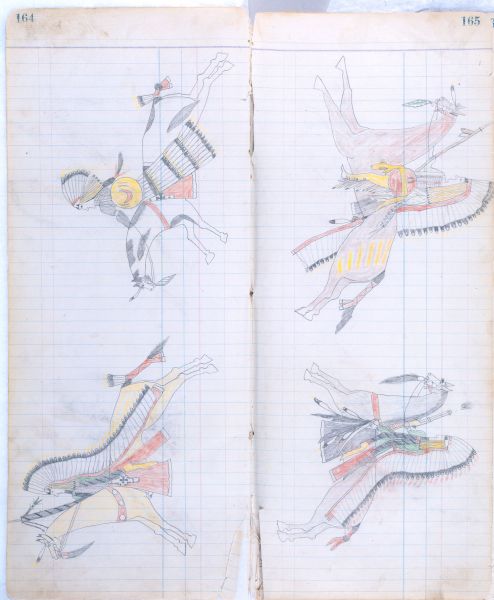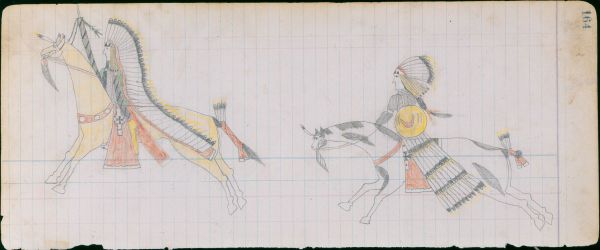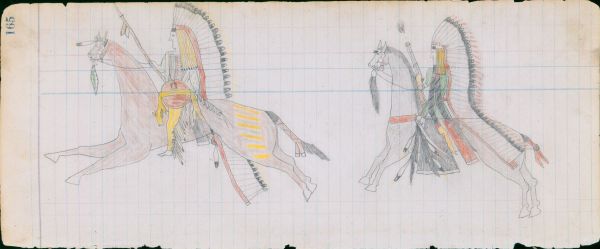PLATE 164-165
Ethnographic Notes
Plate 164
In the origin tale of the Elk Society the founder, Sweet Medicine, appears wearing a "war bonnet...a long one, with small buffalo horns on each side, just above his ears" (Grinnell, 1908a: 291). The eagle feather headdress at left is of this type. Note that the long trailer of red wool cloth has an attached belt of the same material, to keep it centered on the wearer's body.
This man carries an alternate version of the otter-wrapped straight lance, which is unusual in lacking the four pairs of eagle feathers attached along the shaft. It does, however, have the characteristic narrow, paired pendants of twisted otterskin. Only the upper pair of these is visible. At the top of the lance shaft, the tag-end of the otterskin wrapping has been forked, and has four green-dyed fluffs attached along the sides. Undoubtedly, these represent personalized variations. Probably every lance was personalized in some respects. The narrow lance point in this case is formed from the blade of a bayonet, or possibly a sword; while the point of Arrow's lance is made from the sort of blade with cross-tangs commonly sold in the Indian trade, and which could be hafted either as a dagger, or a lance.
It is noteworthy that Arrow represents only the Elk Society straight lances in this record, but neither of the crooked lances which provided the most-common name for the society, in the south. Precisely the reverse situation is documented by the 1898 photograph shown in Cowdrey, 1999: Fig. 5: three crooked lances are shown, but neither of the straight lances. Since the Southern Cheyennes were comprised of several discrete, and often widely separated bands, the only time of the year when all of the members of a society might assemble at once was during the Medicine Lodge, or Sun Dance ceremony, in early summer. It was then that each of the warrior societies was renewed, and new officers selected. The grouped segregation of Elk lances documented both by the drawings and the photograph suggests that the honors these represented may have been rotated on a kin-group basis: one year the two crooked lances may have been awarded to members of the Hevataneo, for example; while the two straight lances were given to worthy warriors of the Hisiometaneo; the whip bearers might have been picked from the Oktogna, etc. After the bands scattered again, this would naturally have tended to segregate the types of society officers who might have been available to accompany any particular war party.
It is also possible that the offices and regalia may have been retained, in an honorific sense, by former owners; so that while there were only two OFFICIAL (or active) crooked lance bearers at any time, on social occasions such as society meetings, or parades during the Medicine Lodge encampment, perhaps many crooked lances might have been displayed. This could explain the three crooked lances in the 1898 photo. Or at that date, a quarter century later than Arrow's drawings, a Northern Cheyenne lance bearer may have been visiting in the south.
This second lance bearer has wrapped his hair in strips of otter fur painted yellow on the flesh side. He wears a green shirt, hairpipe breastplate with red-colored spacers, fully-beaded moccasins, and has a red wool trade cloth blanket laid across his thighs, covering his leggings. This blanket is ornamented with a beaded strip. Compare all three beaded blanket strips in this and the preceding Plate, with the photographic examples in Cowdrey, 1999: Figs. 28 & 58.
The lance bearer's buckskin mare has a silver-mounted headstall, with red-painted reins. An eagle feather is tied to her forelock, and an enemy scalp hangs below her jaw. The scalp is bisected vertically, with halves that are red and white. The horse's tail is wrapped with red trade cloth, and ornamented with a fan of golden eagle tail feathers. The circular ornaments on the horse's red breastband are similar to those shown in Plate 2, and might be either nickel-silver conchos, or round trade mirrors. Either of these would flash and reflect sunlight as the horse moved, simulating bolts of lightning directed at the enemy, precisely like the zigzag face paint of the scalp shirt wearer in Plate 163.
The second rider is garbed much like the first, with the addition of a dentalium-shell choker, and nickel-silver armbands over a black shirt. A striped kerchief is tied to the bit of the white pinto horse. This man carries a war shield with a long trailer hung with four, overlapping tiers of golden eagle feathers. The painted design features a protective, red-crescent moon on a yellow ground, braced by paired, wavy lines which probably represent the paraselenae, or "moon dogs", called by Cheyennes Taesehe- enhataz (Petter, 1915: 717, 1028).
Plate 165
The leading rider carries in his left hand another example of the Elk Society quirt. Here, the stripes are shown as black alternating with uncolored wood, but it is the author's belief that this was an artistic choice dictated by the composition and surrounding colors. Note that across the face of the shield is tied a buffalo calfskin that is colored yellow; and behind this hangs the kit foxskin wrist strap of the quirt, also uncolored. There are no white-colored foxes native to the Plains country; but if Arrow had colored this foxskin yellow, it would have been difficult to distinguish from the calfskin. Indeed, the effect would have ruined the figure, with an amorphous yellow blob at its center. Accordingly, we can be confident that this quirt, which is structurally identical to the one in Plate 163, was also identical in color, with black and yellow stripes.
This man, therefore, is also an officer of the Elk Society. While none of the ethnographic sources specifically mentions scalp-trimmed leggings as part of the official regalia of any Elk officers, this may have been an oversight. Compare these leggings with the Elk Society scalp shirt shown in Plate 163: they share the yellow color, and a hairlock fringe with tubes of yellow-colored ermine fur hung at intervals. If the leggings and shirt were worn together, we would recognize then as a matching set. "Hair-trimmed leggings shared the power of the scalp-fringed war shirts. Like the scalp shirts, these leggings were worn only by the bravest men" (Powell, 1973: 10). The short, black lines painted on the leggings represent coups achieved by this man; the yellow stripes painted on his horse represent the same thing. Note that the dark blue (black) wool breechcloth, worn with the yellow leggings, echo the black and yellow colors of the quirt, underscoring the lightning and thunder imagery which typifies Elk regalia.
The eagle feather headdress worn by this man is especially long, literally trailing on the ground. Structurally, it differs from every other such headdress depicted by Arrow, in that the red wool cloth of the trailer continues as a fillet that encircles the head; rather than being sewn to the back edge of a leather cap, as in the example shown at the right. Also note that the beaded browband hangs down like a visor below this fillet. This type of headdress, which is made like a turban with an open top, is more characteristic of the Cheyennes' Northern Algonkian relatives, the Blackfeet and Crees, and is the much older style. It may have been brought into North America with the earliest immigrants, more than 20,000 years ago, since very similar headdresses are employed by shamanic tribes all across Siberia.
Over a green-spotted calico shirt, this man wears a hairpipe breastplate with red-colored spacers. Occasional examples are seen wherein the leather spacers are covered with red cloth, rather than being painted. In his right hand is carried a lance of personal design---not an Elk Society emblem.It is wrapped with red cloth, has an eagle feather and perhaps some clipped crow feathers near the butt, and a forked pennon near the point.
Cheyennes patterned these pennons after the battle lances of Mexican Soldadoes, the rural militia they sometimes encountered on horse raids into northern Mexico during the first half of the 19th century. (This connection is offered as speculation in Afton, et. al., 1997: 56 & 352. The author is indebted to Dr. Imre Nagy, who informs him that James Mooney's notes include this precise information from Cheyenne informants, who actually fought Mexican troops, admired their lance pennons, and adapted them.)
The shield (Hoano---Petter, 1915:961) carried by this whip bearer has a simple design of an ungulate hoofprint, probably of a buffalo, on a red field. "The Cheyenne think much of the color red, it symbolizes to them life and joy. Dull red, Maetom, is used for ceremonial painting...'Emaohe hoan, the shield is red" (Petter, 1915: 896). Tied across the face of this shield is a tanned buffalo calfskin (Heovoksavoz, "yellow calfskin"---Petter, 1915: 193 & 977), folded along the spine, with the legs, head and tail hanging down as pendants.
Such animalskin attachments to war shields served a variety of purposes. Each Cheyenne shield had its own, unique catalogue of rules and proscriptions for how it must be handled. Between 1902-1906 James Mooney collected extensive descriptions of such rules, now found in his unpublished notes at the Smithsonian Institution [some of these are now Online at: http://www.siris.si.edu ; search "Mooney" and "drawing" ]. From these notes we know that such animalskin covers were untied at night and used to protectively enfold the entire shield. When in camp, at dawn each day the shield must be elevated on a pole or tripod (Hoanono---Petter, 1915: 961), and exposed to the Sun.The animal skin, much like a banner, then was raised above the shield on a lodgepole and leaned against the tripod. At midday the skin, having absorbed the potency of the Sun's rays, was folded as shown here, and tied across the front of the shield. The intent was that the Sun's power should shine out, and blind any enemy (Grinnell, 1923, I: 198). Again at dusk, the skin became a protective wrapper.
A very important drawing of a Southern Cheyenne Sun Dance encampment, attributed to Little Chief, is in the National Museum of the American Indian, Cat. No. 11/1706 (illustrated in Heth, 1992: Fig. 151). It depicts several dozen shields, arranged in groups of identical design, as they would have been displayed in early morning. Many different types of animalskin banners are shown, including newborn (orange) buffalo calf, older (brown) buffalo calf, otter, yearling (spotted) cougar, and bobcat.
One type of shield display shown in the "Little Chief" drawing is detailed in Cowdrey, 1999: Fig. 61. This was a shield design that belonged to Eagle Head (Minimic), his son Howling Wolf (Honehe-nisto), and Many Magpies (Mohehsa Oxhaenosz), also called "Heap of Birds"---all Bowstring Society officers. The "Little Chief" drawing shows six such shields, each supported on a red-painted tripod, and each with an associated banner of newborn buffalo calfskin. These are represented much larger than their actual size. Arrow's drawing is proportionally more accurate. A forked, red pennon hangs at the tip of the pole supporting the calfskin. It is likely that when the shield was carried to war this forked pennon, or one like it, was added to the man's war lance. See the drawing "On the War-path" (Dunn, 1969: no pagination), where Howling Wolf shows himself carrying such a lance.
On an ordinary day in camp, therefore, the shield which Arrow depicts here would likely have been handled in much the same way as those of Howling Wolf, Eagle Head and Many Magpies. The red-and-white pennon shown on this war lance, then would accent the pole on which the calfskin banner was elevated toward the Sun.
Note that this shield is merely hanging from the Cheyenne's shoulders, and resting against his left hip. If forced to retreat under fire, the shield could quickly be swung around to protect the man's back. Compare Plates 124 & 136, where this has been done with willow shields used during sham battles.
The figure on the right is dressed remarkably like the lance bearer in Plate 164---identical green shirts, red breechcloths, otter fur hair wraps, and very similar eagle feather headdresses. It is likely these two men are Nisson relatives. A small difference is that the horsehair accenting the tips of the feathers on this headdress is dyed red, rather than yellow.
Like Arrow in Plates 2, 3 & 5, this man carries a cavalry saber with a split otterskin tied to the hilt and ornamented with golden eagle feathers. Although it is not shown in the drawing, undoubtedly the flesh side of the otterskin is painted yellow, as we see on one of his hair wraps.
This Elk warrior is armed with an 1866 "yellow boy" Winchester carbine, which he is firing into the air in excitement. The diagonal yellow lines shown on the stock represent rows of brass upholstery tacks:
"...some old Indian rifles [had] brass head tacks drove in the stock. This was a common thing for Indians to do. They thought this made the gun look fancy...My father used to sell lots of these brass tacks to all the Indians, to ornament saddles, looking glasses, belts, or anything of that kind" (Bent, 1904-1918: July 6, 1917).
The man's horse has a plain, red trade cloth breastband. The silver-mounted headstalls of both horses in this Plate are accented with chin straps of red cloth. A black, white and green kerchief is tied to the bit of the bay mare; while the scalp of an enemy dangles from the bit of the grey horse. Note the dappled pattern on the chest of this grey. This is an arrangement much like a number of known, Cheyenne war shield designs, such as those of Eagle Head and Howling Wolf, discussed earlier. It is probable that this marking held some mystical significance for the rider, and the horse has been chosen for this war party because of it.


